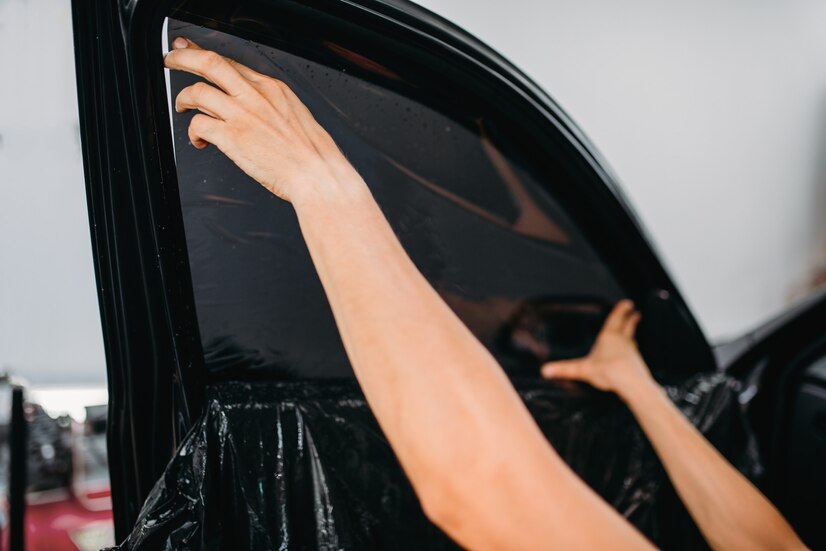Paint protection film (PPF) and window tint are popular automotive aftermarket products that not only add to the aesthetics of the vehicle but also provide protection, comfort, and an improved driving experience. This informative article aims to explore the science and technology behind these products and how they work to safeguard your vehicle while enhancing your driving environment.
How PPF Works: Material Properties and Protection Mechanisms
Paint protection film (PPF) is a thin, clear urethane material that adheres to your vehicle’s paintwork, offering an additional layer of protection from scratches, stone chips, and chemical damage. The PPF’s material properties provide an array of benefits:
- UV Resistance: PPF blocks a significant percentage of the sun’s ultraviolet (UV) rays, preventing paint damage caused by harmful UV exposure, which can lead to paint fading or discoloration.
- Impact Absorption: The film’s tough and flexible nature enables it to absorb the impact of debris and small stones, thereby shielding your car’s paintwork from chipping and scratching.
- Self-Healing Properties: Advanced self-healing PPF is composed of a unique topcoat that can “heal” minor scratches and swirls when exposed to heat, maintaining a fresh and undamaged appearance.
- Chemical Resistance: PPF is highly resistant to chemicals found in bird droppings, tree sap, and other contaminants, preserving the paint’s shine and preventing etching or staining.
By understanding these properties, we can appreciate PPF’s effectiveness in protecting your vehicle’s paintwork, prolonging its pristine appearance, and maintaining its resale value.
How Window Tint Works: Types and Benefits
Window tints are thin layers of specialized film applied to a vehicle’s windows, providing heat reduction, UV protection, and increased privacy. There are three primary types of window tints, each with its unique characteristics and benefits:
- Dyed Tint: Dyed window tints use a polyester layer dyed with colour. They offer a dark appearance for privacy, block UV rays, and absorb solar heat, significantly reducing the temperature inside your car. However, dyed tints may not provide the highest heat reduction compared to other types.
- Metallic Tint: Metallic window tints utilize microscopic metallic particles dispersed within the film. These particles reflect sunlight and UV rays, providing superior heat reduction and glare reduction compared to dyed films. However, they can interfere with radio, GPS, and other electronic signals.
- Ceramic Tint: Ceramic window tints consist of non-metallic, nano-ceramic particles that offer excellent heat reduction, glare reduction, and UV protection without interfering with electronic devices. Although they are the most expensive, they provide the best overall performance and durability.
The Benefits of PPF and Window Tint
Both PPF and window tint offer various benefits for car owners, which contribute to their popularity:
- Enhanced Appearance: A well-installed PPF preserves the original paint’s shine and colour, while window tint can enhance your vehicle’s overall appearance, creating a sleek and customized look.
- Protection: PPF protects your paintwork against environmental damages, such as stone chips and bird droppings, while window tint shields the interior from UV rays and associated fading or cracking.
- Comfort: Window tints provide heat reduction, keeping your car’s interior cooler during hot summer months. In addition, the glare reduction ensures a more comfortable and enjoyable driving experience.
- Privacy and Security: Tinted windows increase privacy by reducing visibility from the outside, while PPF acts as an additional layer of protection against potential vandalism or theft.
The Evolution of PPF and Window Tint Technologies
Over the years, the PPF and window tint industries have evolved, incorporating the latest technology advancements and materials to continually improve their products:
- Nano-Technology: PPF with self-healing properties utilizes nano-technology to return to its original state after minor scratches or damage. Likewise, ceramic window tints use nano-ceramic particles to enhance heat reduction, glare reduction, and UV protection without impacting electronic signals.
- Improved Clarity: Innovative film materials have led to increased optical clarity for both PPF and window tints, providing a virtually invisible and distortion-free appearance.
- Advanced Adhesive Systems: Modern adhesive systems for PPF and window tints offer improved durability, reduced installation times, and enhanced conformity to complicated curves and contours.
- Increased Warranty Lengths: As PPF and window tint technologies improve, manufacturers can offer longer warranty periods, increasing consumer confidence in their products.
Conclusion
Understanding the science and technology behind PPF and window tint allows us to appreciate their value for protecting our vehicles and enhancing our driving experience. As advances in materials and research continue to shape the future of these products, car owners can expect even better performance, aesthetics, and protection for their investment. Don’t hesitate to reach out to professionals like us, who can help guide you in selecting the best PPF and window tint options to meet your unique needs.
Discover the power of PPF and window tint science for yourself! Turn to the experts at Auto Mask for guidance and installation services that will transform your vehicle and driving experience. Contact us today for all your auto tinting needs and more in Montreal.

